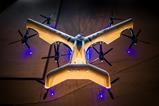Vertical Aerospace has abandoned ambitious plans to fly its latest VX4 prototype at the forthcoming Farnborough air show to instead concentrate on advancing the electric air taxi’s flight-test programme.
UK-based Vertical first raised the possibility of the VX4 performing in Farnborough’s flying display in November last year, one of a series of public flight demonstrations with the electric vertical take-off and landing (eVTOL) aircraft planned for 2024.

But that goal always seemed optimistic, revealed as it was just months after the first, and at that stage only, prototype (G-EVTL) was written off during a flight-test mishap due to a propeller failure.
Although the second prototype is nearing completion at the company’s flight-test centre in Kemble, Gloucestershire and should fly in the coming weeks, Vertical believes the timeline is too tight to permit a Farnborough appearance.
In addition, too many valuable flight-test hours would be lost if the VX4 was sent to the show – requiring disassembly, transport and time spent at the event – the developer adds, as it bids to keep the four-passenger eVTOL aircraft on track for certification in late 2026.
“While it was always going to be ambitious for a novel aircraft prototype programme like ours, we had been aiming to demonstrate the new VX4 at Farnborough,” says Vertical.
“After careful consideration, we decided to prioritise progressing the flight-test programme this summer from our Flight Test Centre instead. Our priority for our latest prototype is achieving piloted flight and this decision will allow us to retain our focus on that.”
Vertical had been hoping to fly the new VX4 in the second quarter but the supply chain complexities seen across the industry have left the build slightly behind schedule.
Nonetheless, the firm is confident that the improvements made to the latest prototype – around 70% of the components are new, including second-generation propellers and its in-house-developed battery pack – will offer significant performance benefits in the long run.
Another identical prototype is due to arrive in the second half of this year. Data from the UK Civil Aviation Authority suggests the two second-generation flight-test aircraft will bear the registrations G-EVTA/EVTB.
Prior to the aircraft taking to the skies again, Vertical also needs to secure a permit to fly from UK regulator.
It plans a piloted flight-test programme for the VX4, beginning with tethered and untethered hovers, followed by thrust- and then wing-borne flights.

In recent social media postings, Vertical has outlined the test programme that underpins assembly of the second VX4 prototype, with the latest achievement the successful completion of structural load limit tests.
“These tests focus on the airframe as a whole, and are key to ensuring our latest full-scale prototype is as safe and efficient as possible ahead of flight tests,” the company says.
Assuming the flight-test campaign proceeds to plan, notably achieving transition from thrust- to wing-borne flight, Vertical still intends to conduct public demonstrations later in 2024.
It has previously outlined plans to operate from Skyports Infrastructure’s new vertiport testbed in Bicester and to perform demonstration flights from London Heathrow airport.
Meanwhile, the company on 31 July will receive the second of two $25 million funding packages from founder Stephen Fitzpatrick.
Fitzpatrick announced in January that he was injecting another $50 million in Vertical, in exchange for warrants and shares valued at $10 each. The first tranche was received in March.
Disclosing the agreement, Vertical said the “second tranche [is] to be reduced by the amount of alternative equity funding secured by the company by [31 July]”.
Although Vertical recently appointed Charlotte Cowley as its new director of strategic finance to head up the fund-raising efforts, it is likely external investors will wait to see flight-test progress before committing.































